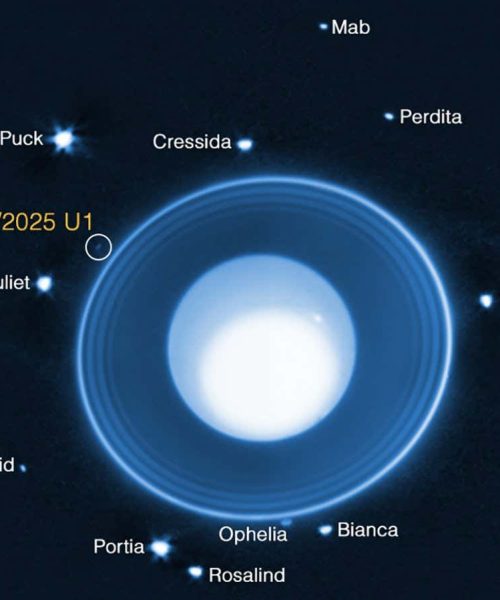
A hotspot analysis of reported “unidentified anomalous phenomena (UAP)” sightings from 2001 to 2020, taken from the paper “An environmental analysis of public UAP sightings and sky view potential”
R. M. Medina et al.
MY FAVOURITE subgenre of scientific papers is “let’s please take this thing seriously even though it’s usually associated with conspiracy theories and cheesy sci-fi movies”. And so it was with glee that I dived into a recent example with the highly technical title “An environmental analysis of public UAP sightings and sky view potential”. Translation: “We looked at where the most people saw UFOs and correlated that with how easy it was to see things in the sky.”
I want to stress at the outset that this isn’t a silly paper, and I’m not implying that we shouldn’t study UFOs as cultural or physical phenomena. The authors, two geographers and a military intelligence expert, are painfully aware of how goofy their research might sound to some readers, and their methods of analysis are completely reasonable.
With that out of the way, I would like to celebrate a few of the acronyms I learned by reading this paper. We shall now refer to UFOs as UAPs, or “unidentified anomalous phenomena”, partly to sidestep the stigma of the pseudoscientific UFO community and partly, I assume, to allow future generations to gather data on giant monsters and other such anomalies not captured by the term “flying object”.
Advertisement
The authors used data from NUFORC, which sounds like a 1970s new wave band, but actually stands for National UFO Reporting Center. You can divulge sightings at its website, and a growing number of people did so during the period studied – 2001 to 2020 – largely due to the greater number of sensors, phones and other technologies that allowed them to record peculiar things in our environment. To study the geographical distribution of these sightings, the authors looked at roughly 200,000 reports on a county-by-county basis in the US. What they found was that more people say they have seen UFOs – erm, UAPs – in the western part of the country, where low population means darker skies overall.
But how exactly did the researchers figure out where all these sightings came from? That brings us to VGI, or “volunteered geographical information”, which the authors acknowledge is “volunteered either knowingly or unknowingly by individuals, typically with the assistance of location-enabled digital tools”. Many phone cameras and apps automatically log the geographical coordinates on pictures you take, whether you know it or not. This is great for friendly scientists looking for data on UAPs, but VGI also gets used in the US by law enforcement and marketing firms to suss out where you are at any given time.
But perhaps my favourite acronym is AARO, or the All-domain Anomaly Resolution Office, a delightfully named unit within the Department of Defense where one of the authors, Sean Kirkpatrick, worked until he quit in disgust late in 2023. The AARO may sound like it was invented by Charles Stross for his Laundry Files series of fantasy novels, but in fact it was convened to determine whether the military secretly had alien “biologics” and spacecraft in its possession. Kirkpatrick told the US Congress the answer was a resounding “no”, then resigned when conspiracy lovers in and out of government continued to insist that there must be something extraterrestrial stashed in the giant warehouse where the Pentagon keeps the Ark of the Covenant and the Holy Grail.
As you might guess from Kirkpatrick’s involvement with this paper, the authors don’t find evidence of alien visitors. What they do find, by correlating the VGI-labelled sightings with data collections that contain the locations of military bases, airports, light pollution, cloud cover and tree canopy, is that most UAPs are spotted in places where it is really easy to look deep into the night sky. According to NUFORC, the most commonly reported UAP turns out to be either a Starlink satellite or the planet Venus. Other reports come from places where it is easy to see human-constructed objects, such as airplanes or drones, moving in swift, irregular patterns through the heavens.
There is also a higher preponderance of reports from areas with “cultures of paranormal ideation”, such as the region around Roswell in New Mexico, the site of a purported UFO crash in the 1940s. Still, the researchers conclude, there are sightings that can’t be explained.
What this paper confirms is that people who report UAPs aren’t mentally ill or hallucinating. There is legitimately weird stuff in the sky. Maybe it isn’t aliens, but our environments produce odd visual effects all the time that are both bizarre and real. And the heavens are full of fantastical objects humans have built, as well as unknowns. Analysing anomalies with scientific rigour doesn’t dispel wonder, it reveals that we can witness wonders every day, right in our own backyards.
Annalee’s week
What I’m reading
Stuart Hall’s classic media studies essay Encoding/Decoding, which is still relevant.
What I’m watching
Dungeon Meshi, an anime about dungeon-to-table cooking.
What I’m working on
Making Google Gemini say weird things.
Annalee Newitz is a science journalist and author. Their latest novel is The Terraformers and they are the co-host of the Hugo-winning podcast Our Opinions Are Correct.
You can follow them @annaleen and their website is techsploitation.com
Topics:





